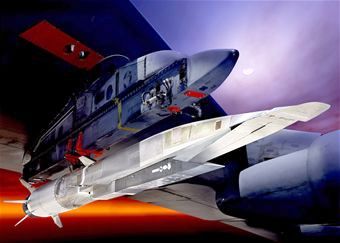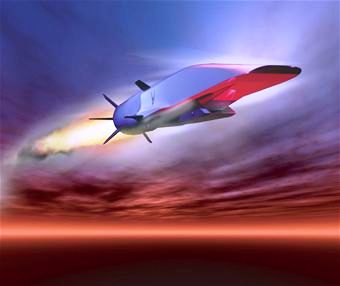WRIGHT-PATTERSON AFB, Ohio - The X-51A Waverider successfully launched from an Air Force B-52 bomber over Point Mugu Naval Air Warfare Center Sea Range Aug. 14 at approximately 11:36 a.m. PST.
The X-51 safely separated from the B-52 and the rocket booster fired as planned. However after 16 seconds, a fault was identified with one of the cruiser control fins. Once the X-51 separated from the rocket booster, approximately 15 seconds later, the cruiser was not able to maintain control due to the faulty control fin and was lost.
"It is unfortunate that a problem with this subsystem caused a termination before we could light the Scramjet engine," said Charlie Brink, X-51A Program Manager for Air Force Research Laboratory. "All our data showed we had created the right conditions for engine ignition and we were very hopeful to meet our test objectives."
This particular control subsystem had proven reliable in the previous two flights of the X-51A including the historic May 2010 flight when the Waverider flew for more than three minutes at Mach 4.88 under scramjet power - nearly five times the speed of sound.
Program officials will now begin the process of working through a rigorous evaluation to determine the exact cause of all factors at play.
One of the four X-51A vehicles remains. AFRL officials have not decided when or if that vehicle will fly at this time. - Wright Patterson AFB
The X-51 safely separated from the B-52 and the rocket booster fired as planned. However after 16 seconds, a fault was identified with one of the cruiser control fins. Once the X-51 separated from the rocket booster, approximately 15 seconds later, the cruiser was not able to maintain control due to the faulty control fin and was lost.
Image may be NSFW.
Clik here to view.
The X-51A Waverider, shown here under the wing of a B-52 Stratofortress, is set to demonstrate hypersonic flight. Powered by a Pratt & Whitney Rocketdyne SJY61 scramjet engine, it is designed to ride on its own shockwave and accelerate to about Mach 6. (U.S. Air Force graphic)
Clik here to view.

The X-51A Waverider, shown here under the wing of a B-52 Stratofortress, is set to demonstrate hypersonic flight. Powered by a Pratt & Whitney Rocketdyne SJY61 scramjet engine, it is designed to ride on its own shockwave and accelerate to about Mach 6. (U.S. Air Force graphic)
"It is unfortunate that a problem with this subsystem caused a termination before we could light the Scramjet engine," said Charlie Brink, X-51A Program Manager for Air Force Research Laboratory. "All our data showed we had created the right conditions for engine ignition and we were very hopeful to meet our test objectives."
Image may be NSFW.
Clik here to view.
The X-51A Waverider is set to demonstrate hypersonic flight. Powered by a Pratt & Whitney Rocketdyne SJY61 scramjet engine, it is designed to ride on its own shockwave and accelerate to about Mach 6. (U.S. Air Force graphic)
Clik here to view.

The X-51A Waverider is set to demonstrate hypersonic flight. Powered by a Pratt & Whitney Rocketdyne SJY61 scramjet engine, it is designed to ride on its own shockwave and accelerate to about Mach 6. (U.S. Air Force graphic)
This particular control subsystem had proven reliable in the previous two flights of the X-51A including the historic May 2010 flight when the Waverider flew for more than three minutes at Mach 4.88 under scramjet power - nearly five times the speed of sound.
Program officials will now begin the process of working through a rigorous evaluation to determine the exact cause of all factors at play.
One of the four X-51A vehicles remains. AFRL officials have not decided when or if that vehicle will fly at this time. - Wright Patterson AFB
